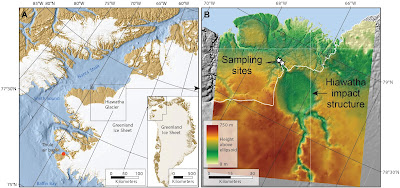在格陵蘭厚達一公里的冰層之下,有個31公里寬的巨大隕石坑――海華沙撞擊坑(Hiawatha
impact crater)。之前猜測這次小行星撞擊是發生在人類出現以後,但是丹麥與瑞典的研究人員最近的定年結果否決了此想法,卻也讓我們對於恐龍時代之後的地球演變過程有新的認識。
2019年研究人員在格陵蘭冰層的邊緣進行野外調查的照片。圖片來源:Pierre Beck
自從2015年哥本哈根大學的GLOBE研究所在格陵蘭西北部發現海華沙撞擊坑之後,它的形成年代所帶來的不確定性就一直是備受猜測的主題。這顆小行星的撞擊時間是否有距今13000年前這麼近,也就是人類已經居住在地球上很長一段時間之後?撞擊是否催生了一段將近1000年的全球冷化――「新仙女木期」(Younger
Dryas)?
最近丹麥自然史博物館、哥本哈根大學GLOBE研究所、斯德哥爾摩瑞典自然史博物館對於海華沙撞擊坑的沙子與岩石顆粒進行分析之後,得到的答案為「否」:海華沙撞擊坑的形成年代要古老得多。事實上,今日發表在期刊《科學前緣》(Science Advances)的新研究表示它的年代為5800萬年。
「要定年這個隕石坑是個極為棘手的問題,所以看到丹麥與瑞典的兩個實驗室運用不同的定年方法而得到同樣的結論,真的讓人相當滿意。因為如此,我相信我們確實得到了海華沙撞擊坑的真實年代,它比之前許多人認為的都老了許多,」丹麥自然史博物館的Michael
Storey表示。
「成功判定撞擊坑的新年代讓我們都相當驚訝,當時是地球歷史上一段重要的時期。這項結果未來可以幫助我們探討撞擊對於當時的氣候可能有什麼影響,」瑞典自然史博物館的Gavin
Kenny博士表示。
哥本哈根大學GLOBE研究所的教授Nicolaj
Krog Larsen作為2015年發現海華沙撞擊坑的一員,他很開心見到此撞擊坑的確切年代終於得到證實。
「終於知道它的年代實在太棒了。我們在七年前發現海華沙撞擊坑之後就一直努力尋找方法來定年。這段期間我們也在該區域進行了幾次野外調查來採集跟海華沙撞擊坑有關的樣品,」Larsen教授表示。
格陵蘭西北方的地圖,顯示海華沙撞擊坑的所在地點(左圖)。冰層下方的地形圖可以清楚看出撞擊坑(右圖)。由哥本哈根大學繪製。
雷射光與沙粒揭露出的年代
海華沙小行星衝擊地球表面釋放的能量相當於數百萬顆原子彈。當時的格陵蘭北部尚未被一公里厚的冰層覆蓋,北極是一片溫帶雨林且有眾多野生生物,攝氏20度是當時的常態。在這之前的八百萬年,有另一顆更大的小行星狠狠撞上今日的墨西哥,造成地球上的恐龍滅亡。
海華沙小行星重擊地球之後留下了31公里寬,1公里深的坑洞,大小足以容下整個華盛頓特區。今日,這個坑洞位於格陵蘭西北部的海華沙冰河之下。研究人員從冰河流出的河水之中,找到距今5800萬年前因為撞擊而被加熱到極高溫的沙子和岩石。
丹麥自然史博物館的研究人員利用雷射加熱沙子直到它們釋放出氬氣,接著再加以分析。而瑞典自然史博物館的研究人員則利用鈾鉛定年法,分析岩石樣品裡的鋯石顆粒。
目前還沒有明確的證據指出海華沙撞擊事件擾動了全球氣候。不過定年結果使得各國研究此撞擊坑的團隊可以開始測試不同的假說,進而深入瞭解撞擊對於全球與當地氣候的影響。
確切來說…
- 全世界已知的撞擊坑大約有200個,寬達31公里的海華沙撞擊坑比其中的90%都還要大。
- 位於當今墨西哥,大約200公里寬的希克蘇魯伯撞擊坑是造成恐龍滅絕的元凶。雖然海華沙撞擊坑的大小遠遠不及於此,但是它勢必會摧毀鄰近地區,甚至有可能對全球氣候與動物造成深遠的影響。
- 距今5800萬年前海華沙撞擊事件發生的時候,地球已經從800萬年之前的希克蘇魯伯撞擊事件造成的浩劫中恢復過來,並且即將邁入一段持續大約500萬年的長期暖化趨勢。
鋯石礦物的微小晶體就像時光膠囊一樣,紀錄了地球歷史上許多事件的發生年代。計算海華沙撞擊坑的年代所用的兩種方法之一,便是定年圖中這類鋯石晶體。圖片來源:Gavin Kenny,瑞典自然史博物館。
Giant impact crater in Greenland
occurred a few million years after dinosaurs went extinct
Danish and Swedish researchers have dated
the enormous Hiawatha impact crater, a 31 km-wide asteroid crater buried under
a kilometer of Greenlandic ice. The dating ends speculation that the asteroid
impacted after the appearance of humans and opens up a new understanding of
Earth’s evolution in the post-dinosaur era.
Ever since 2015, when researchers at the University
of Copenhagen’s GLOBE Institute discovered the Hiawatha impact crater in
northwestern Greenland, uncertainty about the crater’s age has been the subject
of considerable speculation. Could the asteroid have slammed into Earth as
recently as 13,000 years ago, when humans had long populated the planet? Could
its impact have catalyzed a nearly 1,000-year period of global cooling known as
the Younger Dryas?
New analyses performed on grains of sand and rocks
from the Hiawatha impact crater by the Natural History Museum of Denmark and
the GLOBE Institute at the University of Copenhagen, as well as the Swedish
Museum of Natural History in Stockholm, demonstrate that the answer is no. The
Hiawatha impact crater is far older. In fact, a new study published in the
journal Science Advances today
reports its age to be 58 million years old.
"Dating the crater has been a particularly tough
nut to crack, so it’s very satisfying that two laboratories in Denmark and
Sweden, using different dating methods arrived at the same conclusion. As such,
I’m convinced that we’ve determined the crater’s actual age, which is much
older than many people once thought," says Michael Storey of the Natural
History Museum of Denmark.
"Determining the new age of the crater surprised
us all. In the future, it will help us investigate the impact’s possible effect
on climate during an important epoch of Earth's history" says Dr. Gavin
Kenny of the Swedish Museum of Natural History.
As one of those who helped discover the Hiawatha
impact crater in 2015, Professor Nicolaj Krog Larsen of the GLOBE Institute at
the University of Copenhagen is pleased that the crater’s exact age is now
confirmed.
"It is fantastic to now know its age. We've been
working hard to find a way to date the crater since we discovered it seven
years ago. Since then, we have been on several field trips to the area to
collect samples associated with the Hiawatha impact," says Professor Larsen
Age revealed by
laser beams and grains of sand
No kilometer-thick ice sheet draped Northwest
Greenland when the Hiawatha asteroid rammed into Earth surface releasing
several million times more energy than an atomic bomb. At the time, the Arctic
was covered with a temperate rainforest and wildlife abounded – and
temperatures of 20 degrees Celsius were the norm. Eight million years earlier,
an even larger asteroid struck present-day Mexico, causing the extinction of
Earth’s dinosaurs.
The asteroid smashed into Earth, leaving a
thirty-one-kilometer-wide, one-kilometer-deep crater. The crater is big enough
to contain the entire city of Washington D.C. Today, the crater lies beneath
the Hiawatha Glacier in Northwest Greenland. Rivers flowing from the glacier
supplied the researchers with sand and rocks that were superheated by the
impact 58 million years ago.
The sand was analyzed at the Natural History Museum
of Denmark by heating the grains with a laser until they released argon gas,
whereas the rock samples were analyzed at the Swedish Museum of Natural History
using uranium-lead dating of the mineral zircon.
Clear evidence that the Hiawatha impact disrupted
global climate is still lacking. However, the crater’s dating allows the
international research team working on the crater to begin testing various
hypotheses to better understand what its impact was on both the local and
global climate.
Facts
- At 31 km across, the
Hiawatha impact crater is larger than about 90% of the roughly 200
previously known impact craters on Earth.
- Although the Hiawatha
impact crater is much smaller than the approximately 200 km-wide Chicxulub
impact crater in present-day Mexico, which led to the demise of the
dinosaurs, it would have devastated the region and may even have had wider
consequences for the climate and plant and animal life.
- When the Hiawatha impact
occurred 58 million years ago the Earth had recovered from the
catastrophic effects of the Chicxulub impact eight million years earlier
and was entering a long-term warming trend that was to last about 5
million years.
原始論文:Gavin G.
Kenny, William R. Hyde, Michael Storey, Adam A. Garde, Martin J. Whitehouse,
Pierre Beck, Leif Johansson, Anne Sofie Søndergaard, Anders A. Bjørk, Joseph A.
MacGregor, Shfaqat A. Khan, Jérémie Mouginot, Brandon C. Johnson, Elizabeth A.
Silber, Daniel K. P. Wielandt, Kurt H. Kjær, Nicolaj K. Larsen. A Late
Paleocene age for Greenland’s Hiawatha impact structure. Science
Advances, 2022; 8 (10) DOI: 10.1126/sciadv.abm2434
引用自:University of Copenhagen - Faculty of Science.
"Giant impact crater in Greenland occurred a few million years after
dinosaurs went extinct."



沒有留言:
張貼留言